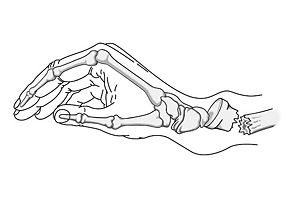Types of fracture
There are lots of fractures. We have tried to narrow it down a wee bit.

Arm and wrist
Top of humerus
Often breaks in the elderly after a fall. Also seen in RTAs. Can be treated conservatively with a collar-and-cuff. If it is comminuted (multiple pieces), may need open reduction and internal fixation.
Colles' fracture
Very common, especially in old osteoporotic ladies who fall forwards on an outstretched hand. You get a dorsal displacement. This means that the back of the hand (the bit with the nails on) goes a bit more backwards. Use some anaesthesia, then reduce it and put it in a backslab.
Smiths' fracture
This is known as a reverse Colles, as its exactly the same, except there is ventral displacement (the hand displaces forwards). It happens when you fall forwards on a flexed hand, or backwards on an outstretched one. Managed the same way.
Scaphoid fracture
Happens from falling on the hand. Get a pain in the anatomical snuff box. Important because there is only a distal blood supply, and a fracture down the middle can mean the proximal end doesn't get blood. Then is dies. That's bad. If it's broken, can usually be supported with a thumb and wrist cast, otherwise, might need surgery.
Leg and Ankle
Neck of femur
Massively common cause of admission in the over 60s. After a fall, pain in the hip and unable to bear weight. Shortened and externally rotated leg. If the fracture is intracapsular (in the ball bit of the ball and socket), usually repair with an arthroplasty. If its outside that, some nice big screws should do the trick.